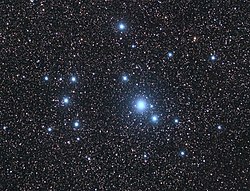| IC 2602 | |
|---|---|
 | |
| Observation data (J2000 epoch) | |
| Right ascension | 10h 42m 57.5s [1] |
| Declination | −64° 23′ 39″ |
| Distance | 486 ly [2] (149 pc) |
| Apparent magnitude (V) | 1.9 [3] |
| Apparent dimensions (V) | 50′ × 50′ |
| Physical characteristics | |
| Estimated age | 13.7 Myr |
| Other designations | Theta Carinae Cluster, Caldwell 102, Cr 229, Mel 102, VDBH 103 [2] |
| Associations | |
| Constellation | Carina |
IC 2602 (also known as the Southern Pleiades, Theta Carinae Cluster, or Caldwell 102) [4] is an open cluster in the constellation Carina. Discovered by Abbe Lacaille in 1751 from South Africa, [5] the cluster is easily visible to the unaided eye, and is one of the nearest star clusters, centred about 149 parsecs (486 light-years) away from Earth.